SSC211e TMA01: Sociology Research on Marriage and Divorce Rates
VerifiedAdded on 2023/04/24
|9
|2036
|284
Report
AI Summary
This report presents a sociological research agenda focused on understanding the social implications of the declining divorce rate and the increasing marriage rate in Singapore. Employing an explanatory research design, the study formulates research questions to explore the connections between these trends. The methodology involves a positivist research philosophy, emphasizing empirical data collection through online surveys, interviews, and questionnaires. Data analysis includes transforming quantitative data into percentages and charts, while qualitative data undergoes thematic analysis. The report also discusses ethical considerations and the selection of the Positivist social science approach. The research aims to provide a detailed analysis of the social phenomenon, offering insights into the factors influencing marriage and divorce rates in Singapore and contributing to the broader understanding of social science research methods.
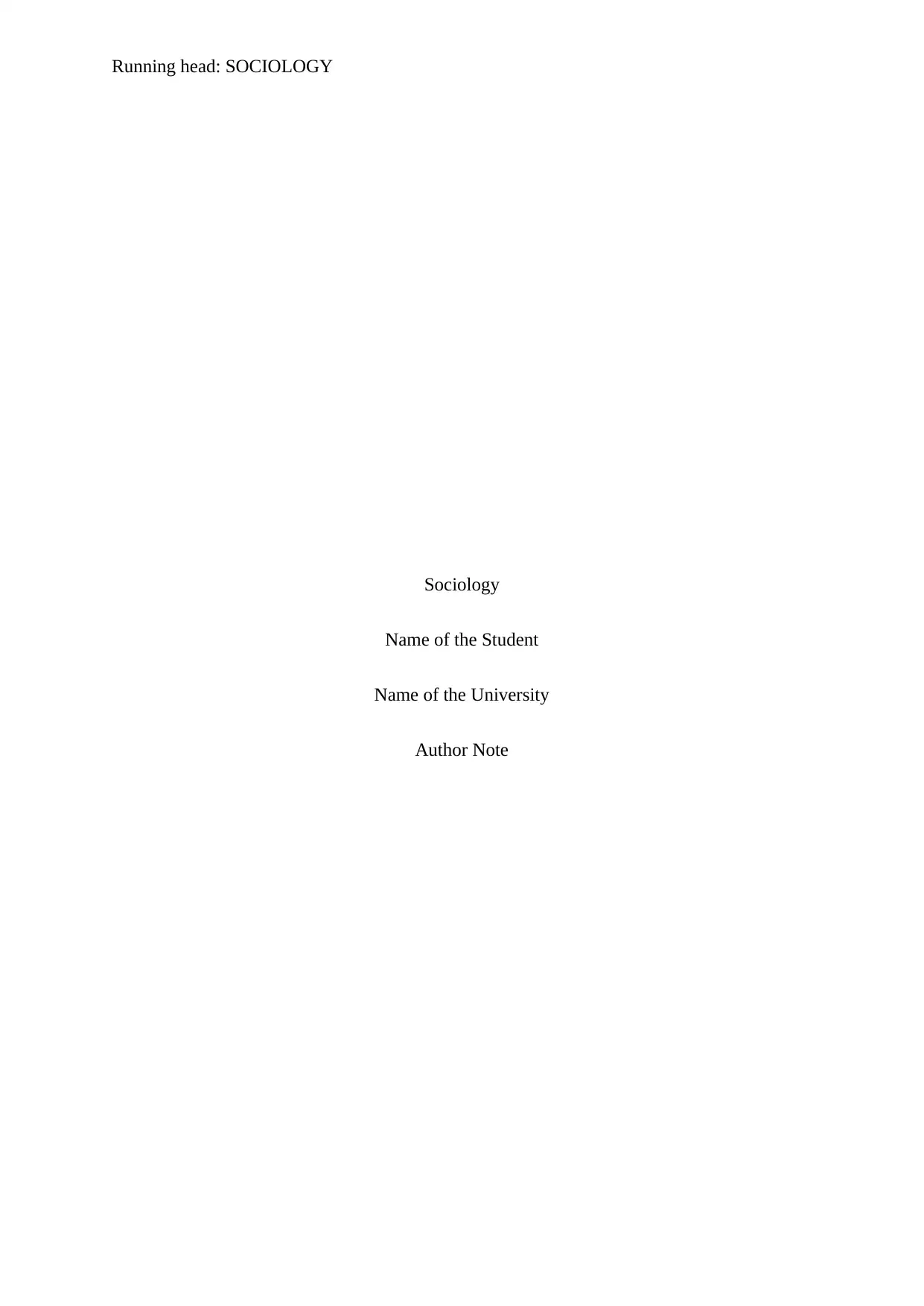
Running head: SOCIOLOGY
Sociology
Name of the Student
Name of the University
Author Note
Sociology
Name of the Student
Name of the University
Author Note
Paraphrase This Document
Need a fresh take? Get an instant paraphrase of this document with our AI Paraphraser
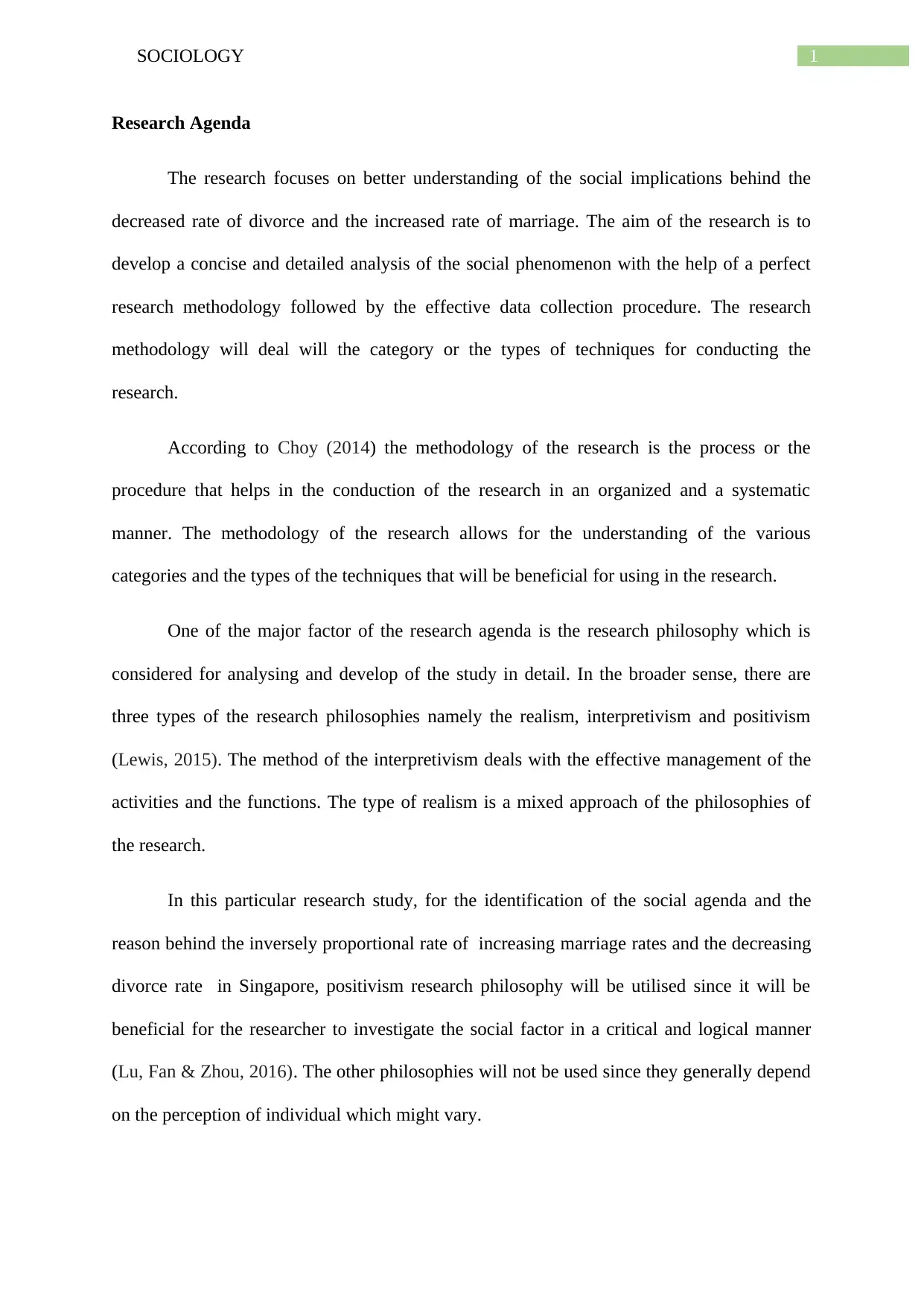
1SOCIOLOGY
Research Agenda
The research focuses on better understanding of the social implications behind the
decreased rate of divorce and the increased rate of marriage. The aim of the research is to
develop a concise and detailed analysis of the social phenomenon with the help of a perfect
research methodology followed by the effective data collection procedure. The research
methodology will deal will the category or the types of techniques for conducting the
research.
According to Choy (2014) the methodology of the research is the process or the
procedure that helps in the conduction of the research in an organized and a systematic
manner. The methodology of the research allows for the understanding of the various
categories and the types of the techniques that will be beneficial for using in the research.
One of the major factor of the research agenda is the research philosophy which is
considered for analysing and develop of the study in detail. In the broader sense, there are
three types of the research philosophies namely the realism, interpretivism and positivism
(Lewis, 2015). The method of the interpretivism deals with the effective management of the
activities and the functions. The type of realism is a mixed approach of the philosophies of
the research.
In this particular research study, for the identification of the social agenda and the
reason behind the inversely proportional rate of increasing marriage rates and the decreasing
divorce rate in Singapore, positivism research philosophy will be utilised since it will be
beneficial for the researcher to investigate the social factor in a critical and logical manner
(Lu, Fan & Zhou, 2016). The other philosophies will not be used since they generally depend
on the perception of individual which might vary.
Research Agenda
The research focuses on better understanding of the social implications behind the
decreased rate of divorce and the increased rate of marriage. The aim of the research is to
develop a concise and detailed analysis of the social phenomenon with the help of a perfect
research methodology followed by the effective data collection procedure. The research
methodology will deal will the category or the types of techniques for conducting the
research.
According to Choy (2014) the methodology of the research is the process or the
procedure that helps in the conduction of the research in an organized and a systematic
manner. The methodology of the research allows for the understanding of the various
categories and the types of the techniques that will be beneficial for using in the research.
One of the major factor of the research agenda is the research philosophy which is
considered for analysing and develop of the study in detail. In the broader sense, there are
three types of the research philosophies namely the realism, interpretivism and positivism
(Lewis, 2015). The method of the interpretivism deals with the effective management of the
activities and the functions. The type of realism is a mixed approach of the philosophies of
the research.
In this particular research study, for the identification of the social agenda and the
reason behind the inversely proportional rate of increasing marriage rates and the decreasing
divorce rate in Singapore, positivism research philosophy will be utilised since it will be
beneficial for the researcher to investigate the social factor in a critical and logical manner
(Lu, Fan & Zhou, 2016). The other philosophies will not be used since they generally depend
on the perception of individual which might vary.
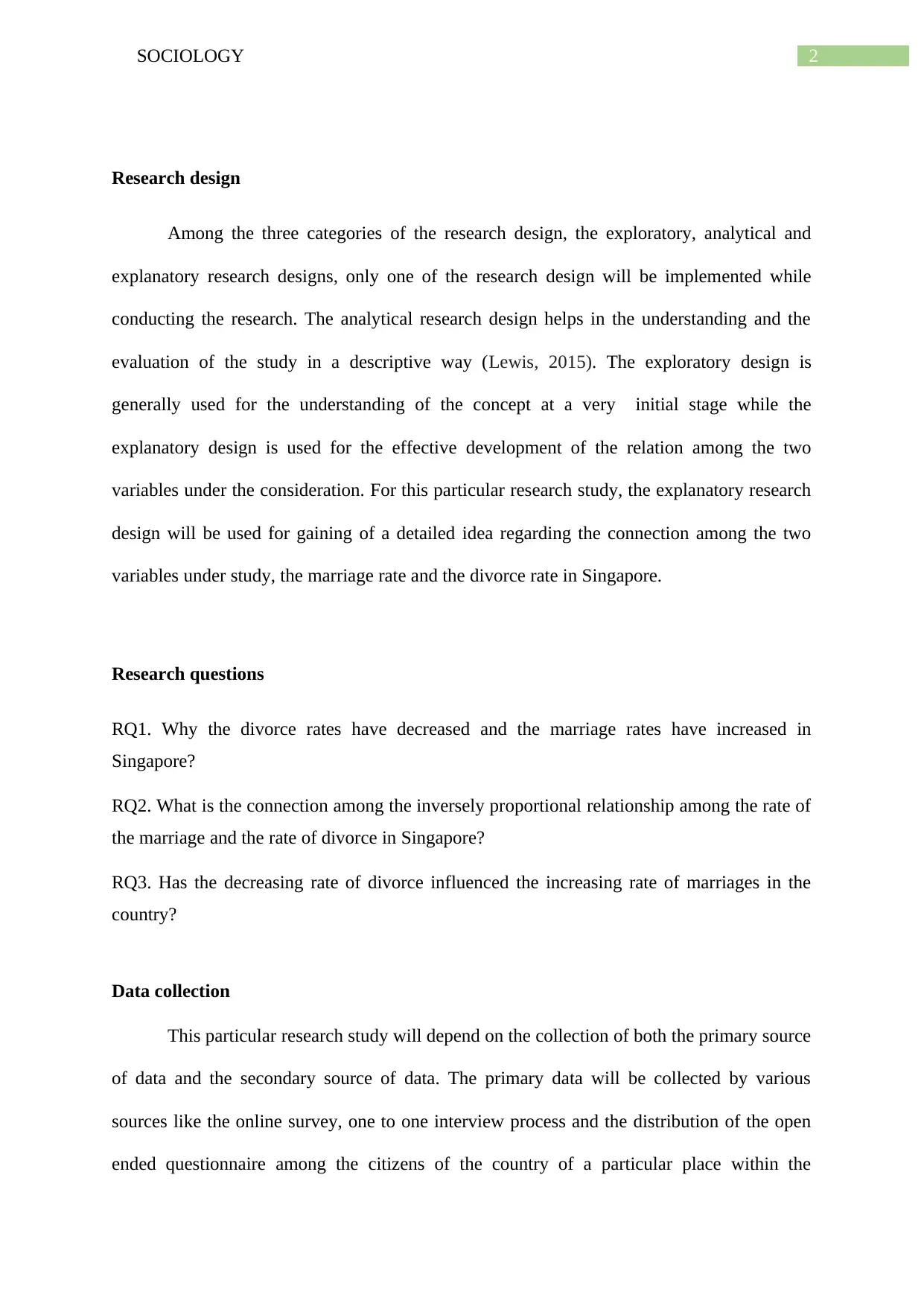
2SOCIOLOGY
Research design
Among the three categories of the research design, the exploratory, analytical and
explanatory research designs, only one of the research design will be implemented while
conducting the research. The analytical research design helps in the understanding and the
evaluation of the study in a descriptive way (Lewis, 2015). The exploratory design is
generally used for the understanding of the concept at a very initial stage while the
explanatory design is used for the effective development of the relation among the two
variables under the consideration. For this particular research study, the explanatory research
design will be used for gaining of a detailed idea regarding the connection among the two
variables under study, the marriage rate and the divorce rate in Singapore.
Research questions
RQ1. Why the divorce rates have decreased and the marriage rates have increased in
Singapore?
RQ2. What is the connection among the inversely proportional relationship among the rate of
the marriage and the rate of divorce in Singapore?
RQ3. Has the decreasing rate of divorce influenced the increasing rate of marriages in the
country?
Data collection
This particular research study will depend on the collection of both the primary source
of data and the secondary source of data. The primary data will be collected by various
sources like the online survey, one to one interview process and the distribution of the open
ended questionnaire among the citizens of the country of a particular place within the
Research design
Among the three categories of the research design, the exploratory, analytical and
explanatory research designs, only one of the research design will be implemented while
conducting the research. The analytical research design helps in the understanding and the
evaluation of the study in a descriptive way (Lewis, 2015). The exploratory design is
generally used for the understanding of the concept at a very initial stage while the
explanatory design is used for the effective development of the relation among the two
variables under the consideration. For this particular research study, the explanatory research
design will be used for gaining of a detailed idea regarding the connection among the two
variables under study, the marriage rate and the divorce rate in Singapore.
Research questions
RQ1. Why the divorce rates have decreased and the marriage rates have increased in
Singapore?
RQ2. What is the connection among the inversely proportional relationship among the rate of
the marriage and the rate of divorce in Singapore?
RQ3. Has the decreasing rate of divorce influenced the increasing rate of marriages in the
country?
Data collection
This particular research study will depend on the collection of both the primary source
of data and the secondary source of data. The primary data will be collected by various
sources like the online survey, one to one interview process and the distribution of the open
ended questionnaire among the citizens of the country of a particular place within the
⊘ This is a preview!⊘
Do you want full access?
Subscribe today to unlock all pages.

Trusted by 1+ million students worldwide
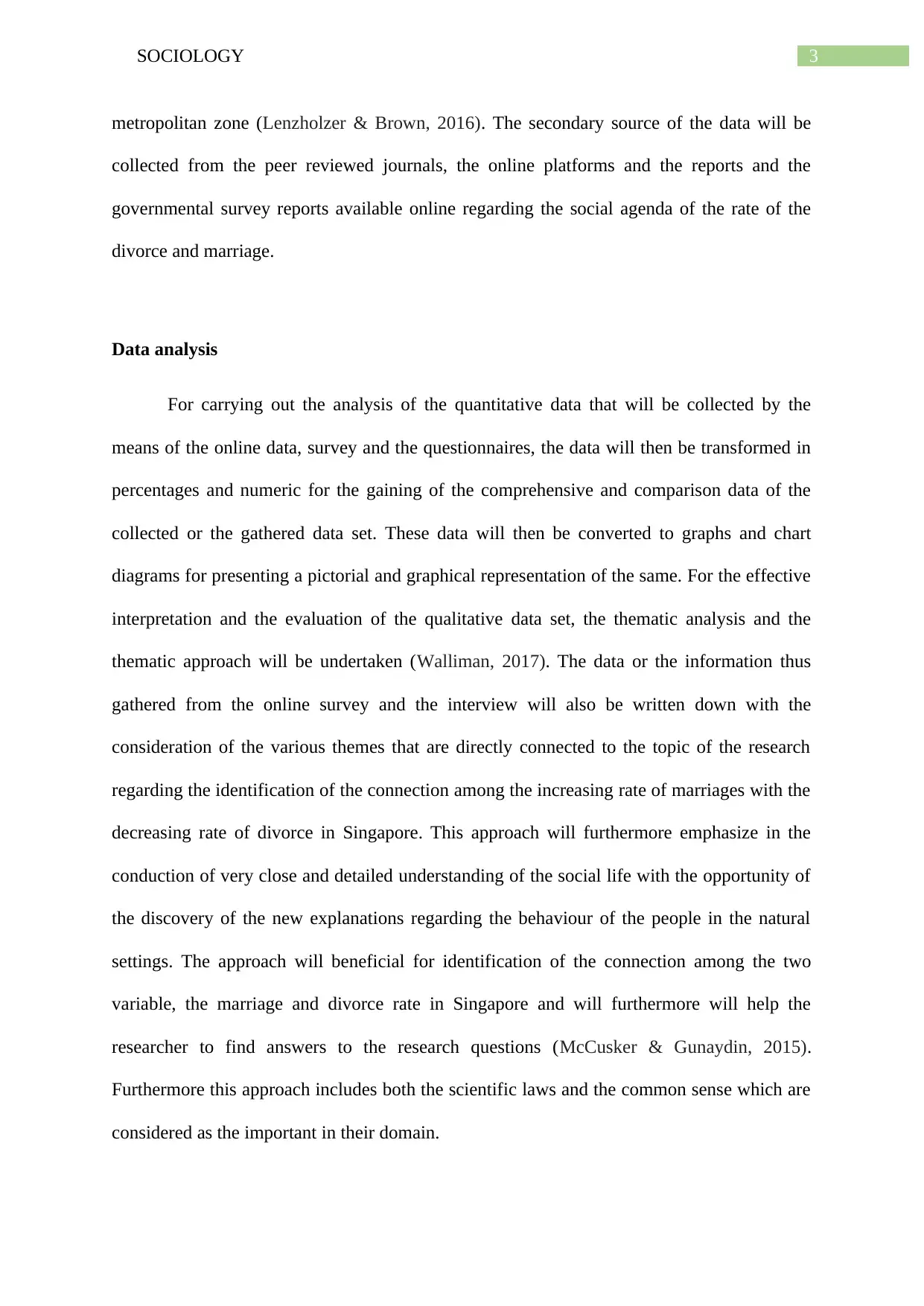
3SOCIOLOGY
metropolitan zone (Lenzholzer & Brown, 2016). The secondary source of the data will be
collected from the peer reviewed journals, the online platforms and the reports and the
governmental survey reports available online regarding the social agenda of the rate of the
divorce and marriage.
Data analysis
For carrying out the analysis of the quantitative data that will be collected by the
means of the online data, survey and the questionnaires, the data will then be transformed in
percentages and numeric for the gaining of the comprehensive and comparison data of the
collected or the gathered data set. These data will then be converted to graphs and chart
diagrams for presenting a pictorial and graphical representation of the same. For the effective
interpretation and the evaluation of the qualitative data set, the thematic analysis and the
thematic approach will be undertaken (Walliman, 2017). The data or the information thus
gathered from the online survey and the interview will also be written down with the
consideration of the various themes that are directly connected to the topic of the research
regarding the identification of the connection among the increasing rate of marriages with the
decreasing rate of divorce in Singapore. This approach will furthermore emphasize in the
conduction of very close and detailed understanding of the social life with the opportunity of
the discovery of the new explanations regarding the behaviour of the people in the natural
settings. The approach will beneficial for identification of the connection among the two
variable, the marriage and divorce rate in Singapore and will furthermore will help the
researcher to find answers to the research questions (McCusker & Gunaydin, 2015).
Furthermore this approach includes both the scientific laws and the common sense which are
considered as the important in their domain.
metropolitan zone (Lenzholzer & Brown, 2016). The secondary source of the data will be
collected from the peer reviewed journals, the online platforms and the reports and the
governmental survey reports available online regarding the social agenda of the rate of the
divorce and marriage.
Data analysis
For carrying out the analysis of the quantitative data that will be collected by the
means of the online data, survey and the questionnaires, the data will then be transformed in
percentages and numeric for the gaining of the comprehensive and comparison data of the
collected or the gathered data set. These data will then be converted to graphs and chart
diagrams for presenting a pictorial and graphical representation of the same. For the effective
interpretation and the evaluation of the qualitative data set, the thematic analysis and the
thematic approach will be undertaken (Walliman, 2017). The data or the information thus
gathered from the online survey and the interview will also be written down with the
consideration of the various themes that are directly connected to the topic of the research
regarding the identification of the connection among the increasing rate of marriages with the
decreasing rate of divorce in Singapore. This approach will furthermore emphasize in the
conduction of very close and detailed understanding of the social life with the opportunity of
the discovery of the new explanations regarding the behaviour of the people in the natural
settings. The approach will beneficial for identification of the connection among the two
variable, the marriage and divorce rate in Singapore and will furthermore will help the
researcher to find answers to the research questions (McCusker & Gunaydin, 2015).
Furthermore this approach includes both the scientific laws and the common sense which are
considered as the important in their domain.
Paraphrase This Document
Need a fresh take? Get an instant paraphrase of this document with our AI Paraphraser
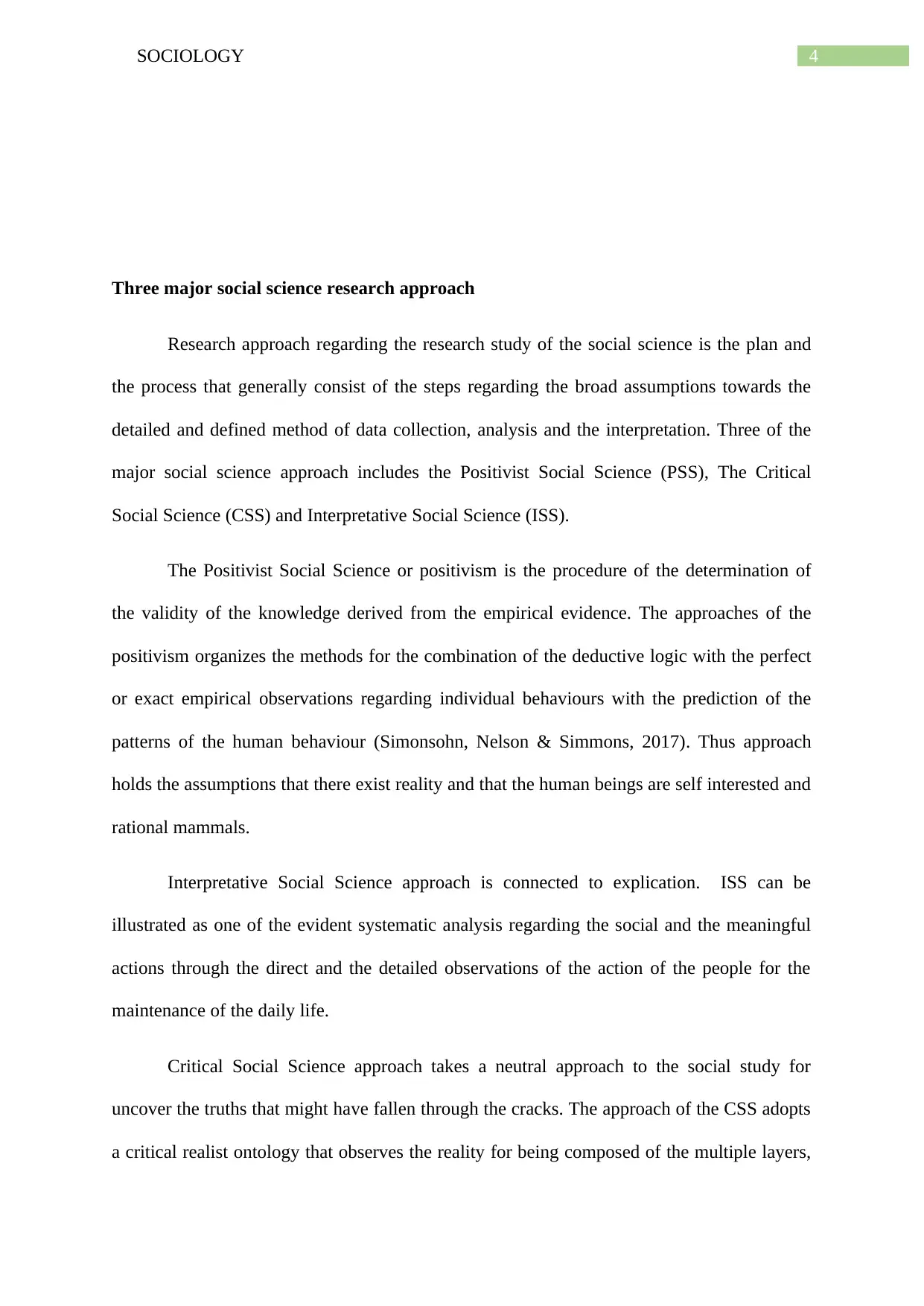
4SOCIOLOGY
Three major social science research approach
Research approach regarding the research study of the social science is the plan and
the process that generally consist of the steps regarding the broad assumptions towards the
detailed and defined method of data collection, analysis and the interpretation. Three of the
major social science approach includes the Positivist Social Science (PSS), The Critical
Social Science (CSS) and Interpretative Social Science (ISS).
The Positivist Social Science or positivism is the procedure of the determination of
the validity of the knowledge derived from the empirical evidence. The approaches of the
positivism organizes the methods for the combination of the deductive logic with the perfect
or exact empirical observations regarding individual behaviours with the prediction of the
patterns of the human behaviour (Simonsohn, Nelson & Simmons, 2017). Thus approach
holds the assumptions that there exist reality and that the human beings are self interested and
rational mammals.
Interpretative Social Science approach is connected to explication. ISS can be
illustrated as one of the evident systematic analysis regarding the social and the meaningful
actions through the direct and the detailed observations of the action of the people for the
maintenance of the daily life.
Critical Social Science approach takes a neutral approach to the social study for
uncover the truths that might have fallen through the cracks. The approach of the CSS adopts
a critical realist ontology that observes the reality for being composed of the multiple layers,
Three major social science research approach
Research approach regarding the research study of the social science is the plan and
the process that generally consist of the steps regarding the broad assumptions towards the
detailed and defined method of data collection, analysis and the interpretation. Three of the
major social science approach includes the Positivist Social Science (PSS), The Critical
Social Science (CSS) and Interpretative Social Science (ISS).
The Positivist Social Science or positivism is the procedure of the determination of
the validity of the knowledge derived from the empirical evidence. The approaches of the
positivism organizes the methods for the combination of the deductive logic with the perfect
or exact empirical observations regarding individual behaviours with the prediction of the
patterns of the human behaviour (Simonsohn, Nelson & Simmons, 2017). Thus approach
holds the assumptions that there exist reality and that the human beings are self interested and
rational mammals.
Interpretative Social Science approach is connected to explication. ISS can be
illustrated as one of the evident systematic analysis regarding the social and the meaningful
actions through the direct and the detailed observations of the action of the people for the
maintenance of the daily life.
Critical Social Science approach takes a neutral approach to the social study for
uncover the truths that might have fallen through the cracks. The approach of the CSS adopts
a critical realist ontology that observes the reality for being composed of the multiple layers,
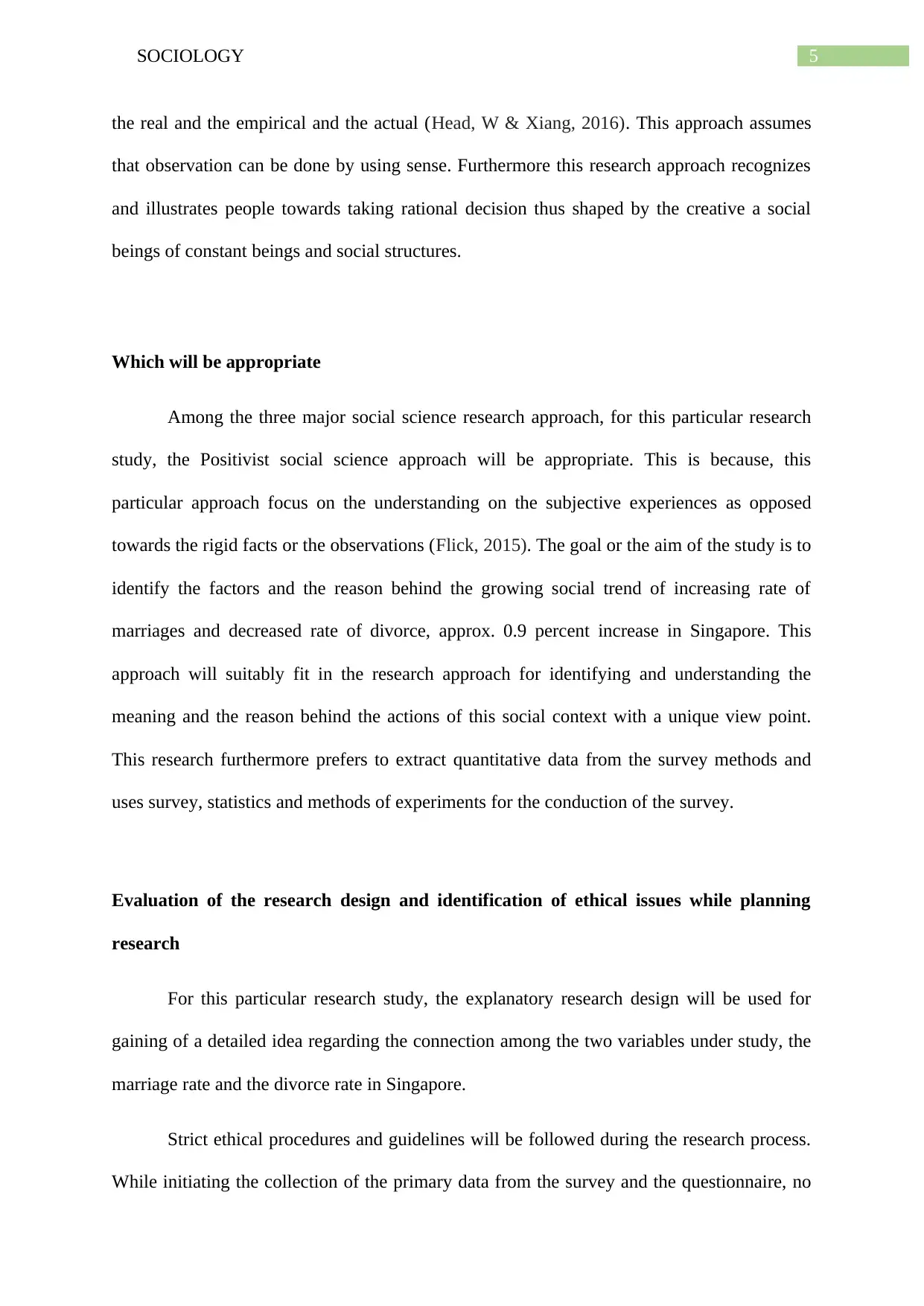
5SOCIOLOGY
the real and the empirical and the actual (Head, W & Xiang, 2016). This approach assumes
that observation can be done by using sense. Furthermore this research approach recognizes
and illustrates people towards taking rational decision thus shaped by the creative a social
beings of constant beings and social structures.
Which will be appropriate
Among the three major social science research approach, for this particular research
study, the Positivist social science approach will be appropriate. This is because, this
particular approach focus on the understanding on the subjective experiences as opposed
towards the rigid facts or the observations (Flick, 2015). The goal or the aim of the study is to
identify the factors and the reason behind the growing social trend of increasing rate of
marriages and decreased rate of divorce, approx. 0.9 percent increase in Singapore. This
approach will suitably fit in the research approach for identifying and understanding the
meaning and the reason behind the actions of this social context with a unique view point.
This research furthermore prefers to extract quantitative data from the survey methods and
uses survey, statistics and methods of experiments for the conduction of the survey.
Evaluation of the research design and identification of ethical issues while planning
research
For this particular research study, the explanatory research design will be used for
gaining of a detailed idea regarding the connection among the two variables under study, the
marriage rate and the divorce rate in Singapore.
Strict ethical procedures and guidelines will be followed during the research process.
While initiating the collection of the primary data from the survey and the questionnaire, no
the real and the empirical and the actual (Head, W & Xiang, 2016). This approach assumes
that observation can be done by using sense. Furthermore this research approach recognizes
and illustrates people towards taking rational decision thus shaped by the creative a social
beings of constant beings and social structures.
Which will be appropriate
Among the three major social science research approach, for this particular research
study, the Positivist social science approach will be appropriate. This is because, this
particular approach focus on the understanding on the subjective experiences as opposed
towards the rigid facts or the observations (Flick, 2015). The goal or the aim of the study is to
identify the factors and the reason behind the growing social trend of increasing rate of
marriages and decreased rate of divorce, approx. 0.9 percent increase in Singapore. This
approach will suitably fit in the research approach for identifying and understanding the
meaning and the reason behind the actions of this social context with a unique view point.
This research furthermore prefers to extract quantitative data from the survey methods and
uses survey, statistics and methods of experiments for the conduction of the survey.
Evaluation of the research design and identification of ethical issues while planning
research
For this particular research study, the explanatory research design will be used for
gaining of a detailed idea regarding the connection among the two variables under study, the
marriage rate and the divorce rate in Singapore.
Strict ethical procedures and guidelines will be followed during the research process.
While initiating the collection of the primary data from the survey and the questionnaire, no
⊘ This is a preview!⊘
Do you want full access?
Subscribe today to unlock all pages.

Trusted by 1+ million students worldwide
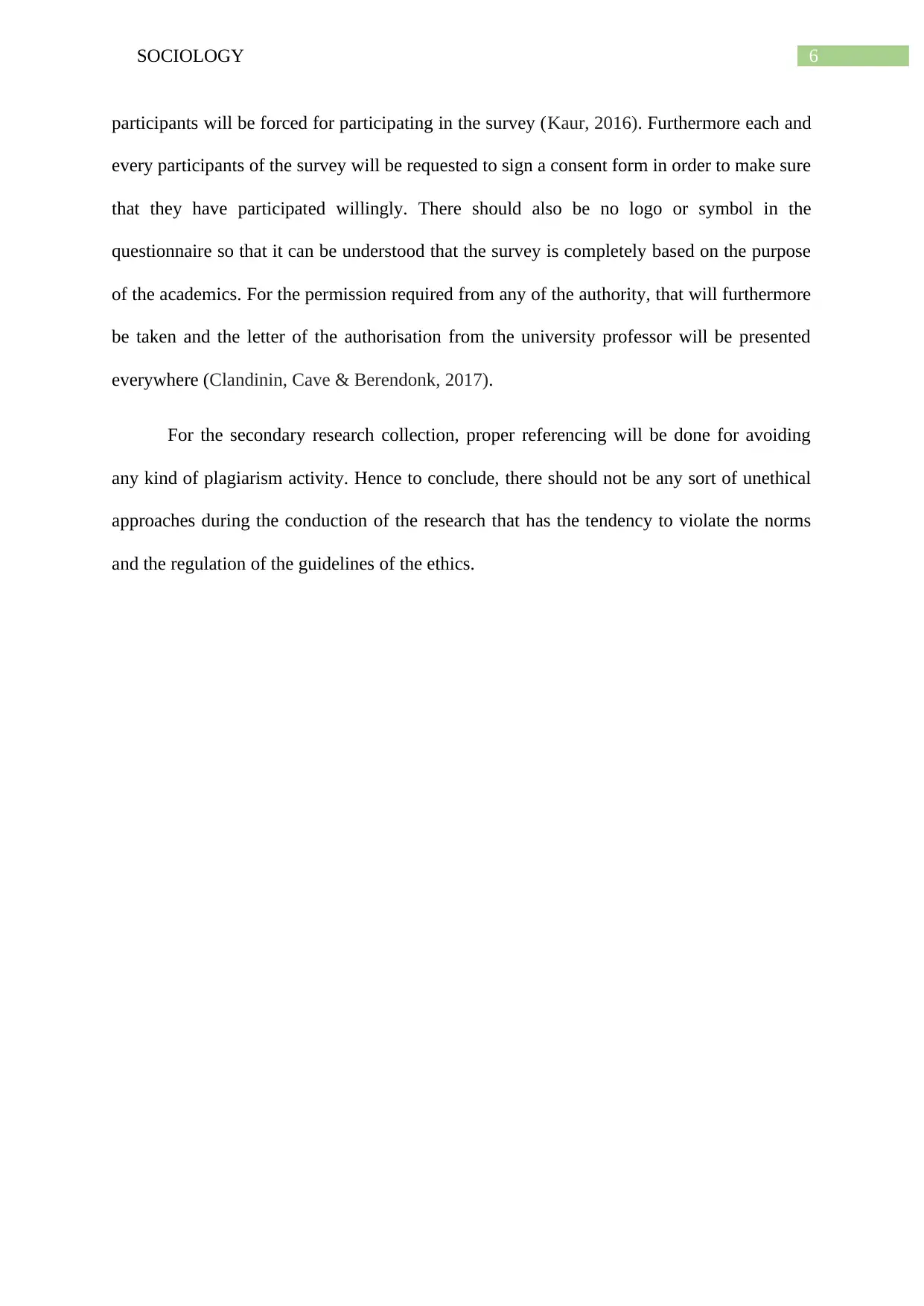
6SOCIOLOGY
participants will be forced for participating in the survey (Kaur, 2016). Furthermore each and
every participants of the survey will be requested to sign a consent form in order to make sure
that they have participated willingly. There should also be no logo or symbol in the
questionnaire so that it can be understood that the survey is completely based on the purpose
of the academics. For the permission required from any of the authority, that will furthermore
be taken and the letter of the authorisation from the university professor will be presented
everywhere (Clandinin, Cave & Berendonk, 2017).
For the secondary research collection, proper referencing will be done for avoiding
any kind of plagiarism activity. Hence to conclude, there should not be any sort of unethical
approaches during the conduction of the research that has the tendency to violate the norms
and the regulation of the guidelines of the ethics.
participants will be forced for participating in the survey (Kaur, 2016). Furthermore each and
every participants of the survey will be requested to sign a consent form in order to make sure
that they have participated willingly. There should also be no logo or symbol in the
questionnaire so that it can be understood that the survey is completely based on the purpose
of the academics. For the permission required from any of the authority, that will furthermore
be taken and the letter of the authorisation from the university professor will be presented
everywhere (Clandinin, Cave & Berendonk, 2017).
For the secondary research collection, proper referencing will be done for avoiding
any kind of plagiarism activity. Hence to conclude, there should not be any sort of unethical
approaches during the conduction of the research that has the tendency to violate the norms
and the regulation of the guidelines of the ethics.
Paraphrase This Document
Need a fresh take? Get an instant paraphrase of this document with our AI Paraphraser
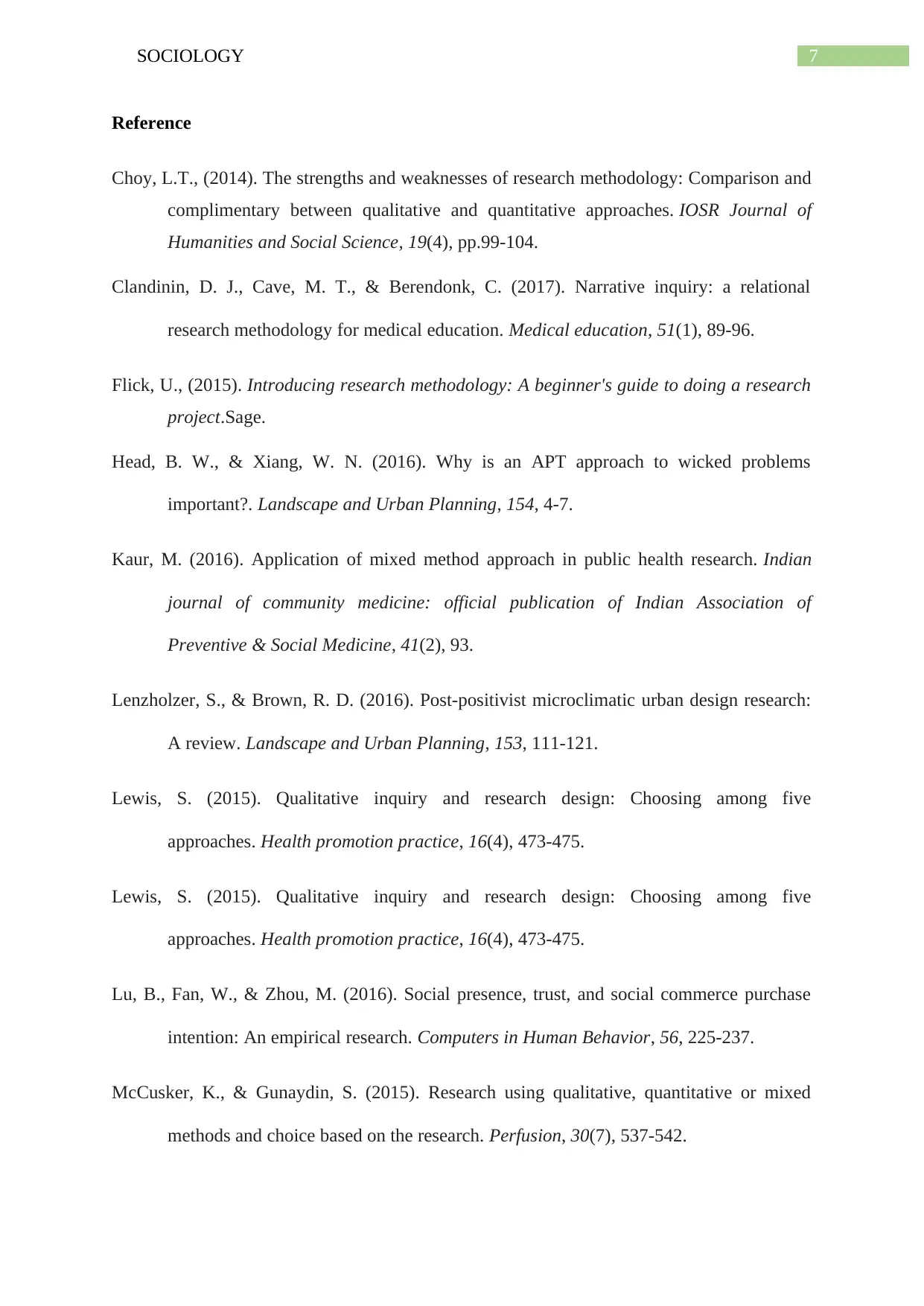
7SOCIOLOGY
Reference
Choy, L.T., (2014). The strengths and weaknesses of research methodology: Comparison and
complimentary between qualitative and quantitative approaches. IOSR Journal of
Humanities and Social Science, 19(4), pp.99-104.
Clandinin, D. J., Cave, M. T., & Berendonk, C. (2017). Narrative inquiry: a relational
research methodology for medical education. Medical education, 51(1), 89-96.
Flick, U., (2015). Introducing research methodology: A beginner's guide to doing a research
project.Sage.
Head, B. W., & Xiang, W. N. (2016). Why is an APT approach to wicked problems
important?. Landscape and Urban Planning, 154, 4-7.
Kaur, M. (2016). Application of mixed method approach in public health research. Indian
journal of community medicine: official publication of Indian Association of
Preventive & Social Medicine, 41(2), 93.
Lenzholzer, S., & Brown, R. D. (2016). Post-positivist microclimatic urban design research:
A review. Landscape and Urban Planning, 153, 111-121.
Lewis, S. (2015). Qualitative inquiry and research design: Choosing among five
approaches. Health promotion practice, 16(4), 473-475.
Lewis, S. (2015). Qualitative inquiry and research design: Choosing among five
approaches. Health promotion practice, 16(4), 473-475.
Lu, B., Fan, W., & Zhou, M. (2016). Social presence, trust, and social commerce purchase
intention: An empirical research. Computers in Human Behavior, 56, 225-237.
McCusker, K., & Gunaydin, S. (2015). Research using qualitative, quantitative or mixed
methods and choice based on the research. Perfusion, 30(7), 537-542.
Reference
Choy, L.T., (2014). The strengths and weaknesses of research methodology: Comparison and
complimentary between qualitative and quantitative approaches. IOSR Journal of
Humanities and Social Science, 19(4), pp.99-104.
Clandinin, D. J., Cave, M. T., & Berendonk, C. (2017). Narrative inquiry: a relational
research methodology for medical education. Medical education, 51(1), 89-96.
Flick, U., (2015). Introducing research methodology: A beginner's guide to doing a research
project.Sage.
Head, B. W., & Xiang, W. N. (2016). Why is an APT approach to wicked problems
important?. Landscape and Urban Planning, 154, 4-7.
Kaur, M. (2016). Application of mixed method approach in public health research. Indian
journal of community medicine: official publication of Indian Association of
Preventive & Social Medicine, 41(2), 93.
Lenzholzer, S., & Brown, R. D. (2016). Post-positivist microclimatic urban design research:
A review. Landscape and Urban Planning, 153, 111-121.
Lewis, S. (2015). Qualitative inquiry and research design: Choosing among five
approaches. Health promotion practice, 16(4), 473-475.
Lewis, S. (2015). Qualitative inquiry and research design: Choosing among five
approaches. Health promotion practice, 16(4), 473-475.
Lu, B., Fan, W., & Zhou, M. (2016). Social presence, trust, and social commerce purchase
intention: An empirical research. Computers in Human Behavior, 56, 225-237.
McCusker, K., & Gunaydin, S. (2015). Research using qualitative, quantitative or mixed
methods and choice based on the research. Perfusion, 30(7), 537-542.
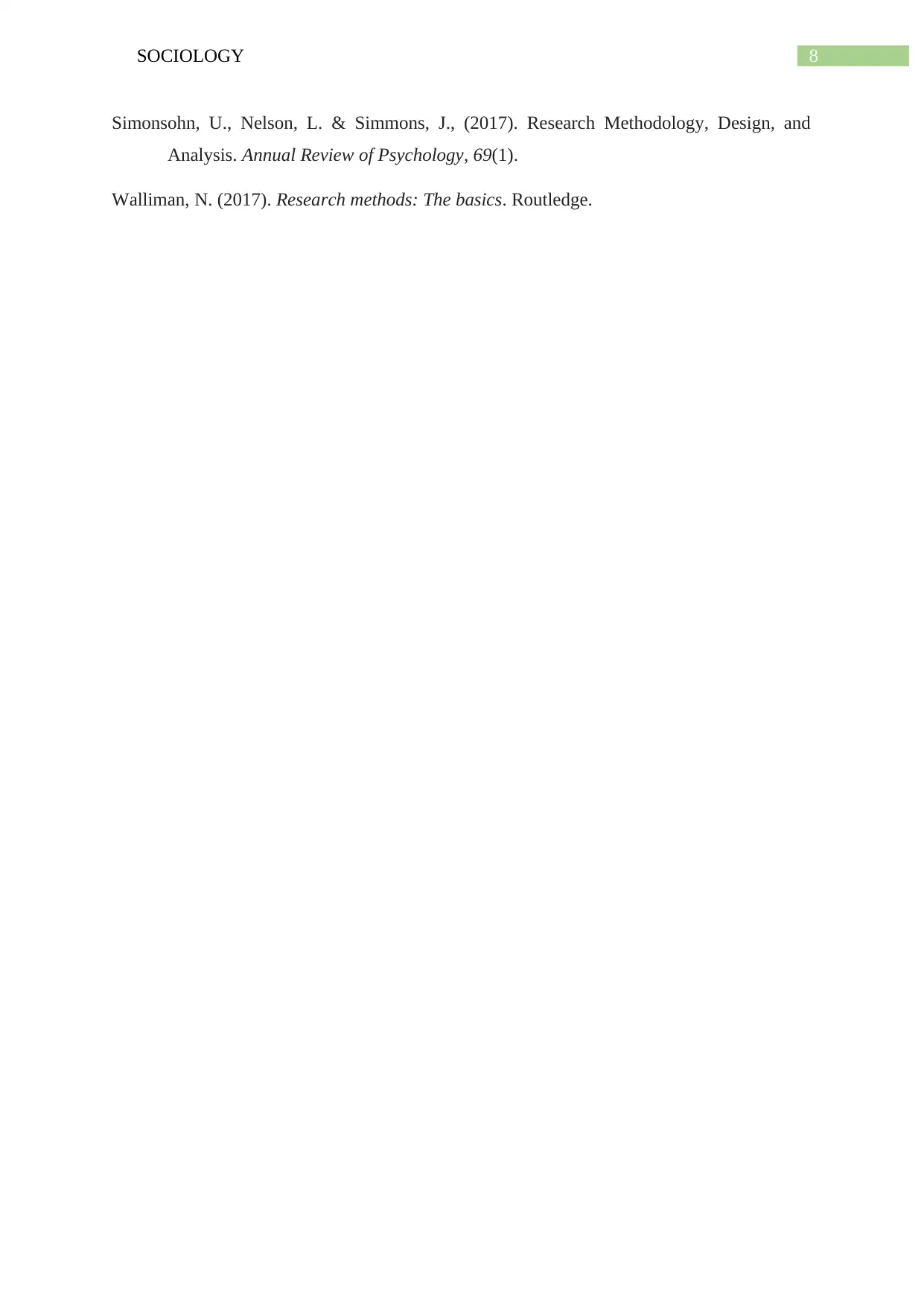
8SOCIOLOGY
Simonsohn, U., Nelson, L. & Simmons, J., (2017). Research Methodology, Design, and
Analysis. Annual Review of Psychology, 69(1).
Walliman, N. (2017). Research methods: The basics. Routledge.
Simonsohn, U., Nelson, L. & Simmons, J., (2017). Research Methodology, Design, and
Analysis. Annual Review of Psychology, 69(1).
Walliman, N. (2017). Research methods: The basics. Routledge.
⊘ This is a preview!⊘
Do you want full access?
Subscribe today to unlock all pages.

Trusted by 1+ million students worldwide
1 out of 9
Related Documents
Your All-in-One AI-Powered Toolkit for Academic Success.
+13062052269
info@desklib.com
Available 24*7 on WhatsApp / Email
![[object Object]](/_next/static/media/star-bottom.7253800d.svg)
Unlock your academic potential
Copyright © 2020–2025 A2Z Services. All Rights Reserved. Developed and managed by ZUCOL.





